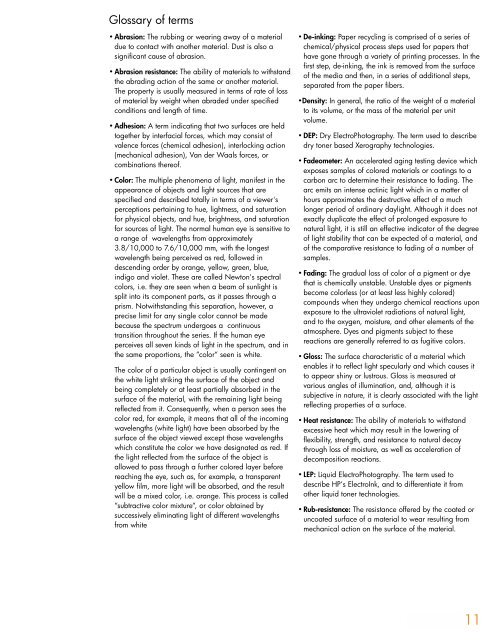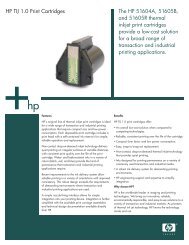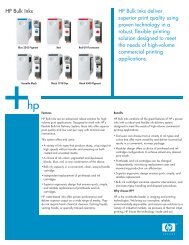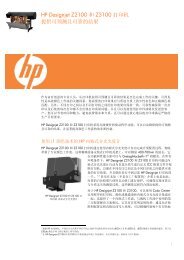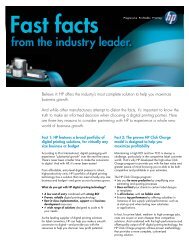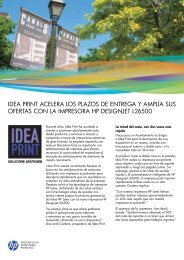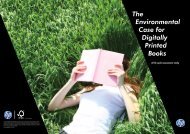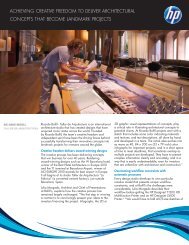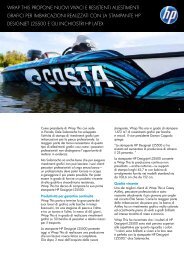HP ElectroInk Frequently Asked Questions - Hewlett Packard
HP ElectroInk Frequently Asked Questions - Hewlett Packard
HP ElectroInk Frequently Asked Questions - Hewlett Packard
Create successful ePaper yourself
Turn your PDF publications into a flip-book with our unique Google optimized e-Paper software.
Glossary of terms<br />
• Abrasion: The rubbing or wearing away of a material<br />
due to contact with another material. Dust is also a<br />
significant cause of abrasion.<br />
• Abrasion resistance: The ability of materials to withstand<br />
the abrading action of the same or another material.<br />
The property is usually measured in terms of rate of loss<br />
of material by weight when abraded under specified<br />
conditions and length of time.<br />
• Adhesion: A term indicating that two surfaces are held<br />
together by interfacial forces, which may consist of<br />
valence forces (chemical adhesion), interlocking action<br />
(mechanical adhesion), Van der Waals forces, or<br />
combinations thereof.<br />
• Color: The multiple phenomena of light, manifest in the<br />
appearance of objects and light sources that are<br />
specified and described totally in terms of a viewer's<br />
perceptions pertaining to hue, lightness, and saturation<br />
for physical objects, and hue, brightness, and saturation<br />
for sources of light. The normal human eye is sensitive to<br />
a range of wavelengths from approximately<br />
3.8/10,000 to 7.6/10,000 mm, with the longest<br />
wavelength being perceived as red, followed in<br />
descending order by orange, yellow, green, blue,<br />
indigo and violet. These are called Newton's spectral<br />
colors, i.e. they are seen when a beam of sunlight is<br />
split into its component parts, as it passes through a<br />
prism. Notwithstanding this separation, however, a<br />
precise limit for any single color cannot be made<br />
because the spectrum undergoes a continuous<br />
transition throughout the series. If the human eye<br />
perceives all seven kinds of light in the spectrum, and in<br />
the same proportions, the “color“ seen is white.<br />
The color of a particular object is usually contingent on<br />
the white light striking the surface of the object and<br />
being completely or at least partially absorbed in the<br />
surface of the material, with the remaining light being<br />
reflected from it. Consequently, when a person sees the<br />
color red, for example, it means that all of the incoming<br />
wavelengths (white light) have been absorbed by the<br />
surface of the object viewed except those wavelengths<br />
which constitute the color we have designated as red. If<br />
the light reflected from the surface of the object is<br />
allowed to pass through a further colored layer before<br />
reaching the eye, such as, for example, a transparent<br />
yellow film, more light will be absorbed, and the result<br />
will be a mixed color, i.e. orange. This process is called<br />
“subtractive color mixture“, or color obtained by<br />
successively eliminating light of different wavelengths<br />
from white<br />
• De-inking: Paper recycling is comprised of a series of<br />
chemical/physical process steps used for papers that<br />
have gone through a variety of printing processes. In the<br />
first step, de-inking, the ink is removed from the surface<br />
of the media and then, in a series of additional steps,<br />
separated from the paper fibers.<br />
•Density: In general, the ratio of the weight of a material<br />
to its volume, or the mass of the material per unit<br />
volume.<br />
• DEP: Dry ElectroPhotography. The term used to describe<br />
dry toner based Xerography technologies.<br />
• Fadeometer: An accelerated aging testing device which<br />
exposes samples of colored materials or coatings to a<br />
carbon arc to determine their resistance to fading. The<br />
arc emits an intense actinic light which in a matter of<br />
hours approximates the destructive effect of a much<br />
longer period of ordinary daylight. Although it does not<br />
exactly duplicate the effect of prolonged exposure to<br />
natural light, it is still an effective indicator of the degree<br />
of light stability that can be expected of a material, and<br />
of the comparative resistance to fading of a number of<br />
samples.<br />
• Fading: The gradual loss of color of a pigment or dye<br />
that is chemically unstable. Unstable dyes or pigments<br />
become colorless (or at least less highly colored)<br />
compounds when they undergo chemical reactions upon<br />
exposure to the ultraviolet radiations of natural light,<br />
and to the oxygen, moisture, and other elements of the<br />
atmosphere. Dyes and pigments subject to these<br />
reactions are generally referred to as fugitive colors.<br />
• Gloss: The surface characteristic of a material which<br />
enables it to reflect light specularly and which causes it<br />
to appear shiny or lustrous. Gloss is measured at<br />
various angles of illumination, and, although it is<br />
subjective in nature, it is clearly associated with the light<br />
reflecting properties of a surface.<br />
• Heat resistance: The ability of materials to withstand<br />
excessive heat which may result in the lowering of<br />
flexibility, strength, and resistance to natural decay<br />
through loss of moisture, as well as acceleration of<br />
decomposition reactions.<br />
• LEP: Liquid ElectroPhotography. The term used to<br />
describe <strong>HP</strong>’s <strong>ElectroInk</strong>, and to differentiate it from<br />
other liquid toner technologies.<br />
• Rub-resistance: The resistance offered by the coated or<br />
uncoated surface of a material to wear resulting from<br />
mechanical action on the surface of the material.<br />
11


